|
1 -
THE FIRST ENCOUNTERS
Divine Encounters are the ultimate human experience - the maximal, the
utmost possible when alive, as when Moses encountered the Lord upon
Mount Sinai; and the final, terminal, and conclusive, as that of
Egyptian Pharaohs who at death assumed an eternal Afterlife by
joining the Gods in their Divine Abode.

The human experience of Divine Encounters as recorded in scriptures
and texts from the ancient Near East is a most amazing and
fascinating saga. It is a powerful drama that spans Heaven and
Earth, involving worship and devotion, eternity and morality on the
one hand, and love and sex, jealousy and murder on the other;
ascents unto space and journeys to the Netherworld.
A stage on which
the actors are Gods and Goddesses, angels and demiGods, Earthlings
and androids; a drama expressed in prophecies and visions, in dreams
and omens and oracles and revelations. It is a story of Man,
separated from his Creator, seeking to restore a primeval umbilical
cord and, by so doing, reach for the stars.
Divine Encounters are the ultimate human experience perhaps because
they were also the very first human experience; for when God created
Man, Man met God at the very moment of being created. We read in
Genesis, the first book of the Hebrew Bible, how the first human,
"The Adam," was brought into being:
And God said: Let us make Man
in our image, after our likeness ...
And God created the Adam in His image, in the image of Elohim
created He him.
We can only surmise that the newborn, at the moment of being brought
forth, was hardly aware of the nature and significance of that first
Divine Encounter. Nor, it appears, was The Adam fully aware of an
ensuing crucial encounter, when the Lord God (in the creation
version attributed to
Yahweh) decided to create a female mate for
The Adam:
And Yahweh Elohim
caused a deep sleep to fall upon
the Adam, and he slept.
And he took one of his ribs
and closed up the flesh instead of it.
And Yahweh Elohim formed the rib
which He had taken from the Adam
into a woman.
The first man was thus deeply anesthetized during the proceedings,
and therefore oblivious to this crucial Divine Encounter in which
the Lord Yahweh displayed his surgical talents. But The Adam was
soon informed of what had happened, for the Lord God "brought the
woman unto the man" and introduced her to him. The Bible then offers
a few words of commentary on why men and women become "one flesh"
as they marry and ends the tale with the observation that both the
man and his wife "were naked, but were not ashamed."
While the
situation seemed not to bother the First Matchmaker, why does the
Bible imply otherwise? If the other creatures roaming in the Garden
of Eden, "the beasts of the field and the fowl of the skies," were
unclothed, what on Earth should have caused (but did not) Adam and
Eve to be ashamed of being naked? Was it because the ones in whose
image the Adam was created were wearing clothing? It is a point to
be kept in mind - a clue, an inadvertent clue provided by the Bible,
regarding the identity of the Elohim.
No one after Adam and Eve could attain the experience of being the
first humans on Earth, with the attendant first Divine Encounters.
But what has ensued in the Garden of Eden
has endured as part of human yearning unto our own days. Even chosen
Prophets must have longed to be so privileged, for it was there, in
the Garden of Eden, that God spoke directly to the first human
beings, instructing them regarding their nourishment: They can eat
of all the garden’s fruits, except the fruit of the Tree of Knowing.
The chain of events leading to the Expulsion from Paradise raises a
lasting question:
-
How did Adam and Eve hear God
- how does God
communicate with humans at such, or any, Divine Encounters?
-
Can the
humans see the divine speaker, or just hear the message?
-
And how is
the message conveyed - face-to-face?
-
Telepathically?
-
In a holographic
vision?
-
Through the medium of dreams?
We shall examine the ancient evidence for the answers. But as far as
the events in the Garden of Eden are concerned, the biblical text
suggests a physical divine presence. The place was not a human
habitat; rather, it was a divine abode, an orchard deliberately
planted "in Eden, in the east," where God "put the Adam whom He had
fashioned" to serve as a gardener, "to till it and to keep it."
It is in this garden that Adam and Eve, through the intervention of
the Divine Serpent, discover their sexuality after eating of the
fruit of the Tree of Knowing that "makes one wise." Having eaten the
forbidden fruit, "they knew that they were naked, and they sewed fig
leaves together and made themselves aprons."
Now the Lord God -
Yahweh Elohim in the Hebrew Bible - enters the stage:
And they heard the sound of the Lord God walking in the garden in
the cool of the day; And Adam and his wife hid themselves from the
presence of the Lord God amongst the trees of the garden.
God is physically present in the Garden of Eden, and the sound of
his strolling about the garden can be heard by the humans. Can they
see the deity? The biblical narrative is silent on the issue; it
makes clear, however, that God can see them - or, in this instance,
was expecting to see them but
could not because they were hiding. So God used his voice to reach
them: "And the Lord God called unto the Adam, and said unto him:
Where art thou?"
A dialogue (or more correctly a trialogue) ensues. The tale raises
many issues of great import. It suggests that The Adam could talk
from the very beginning; it brings up the question of how - in what
tongue - did God and Man converse. For the moment let us just pursue
the biblical tale: Adam’s explanation, that he hid on hearing God’s
approach "because I am naked" leads to the questioning of the human
pair by the deity.
In the full-scale conversation that follows the
truth comes out and the sin of eating the forbidden fruit is
admitted (though only after Adam and Eve blame the Serpent for the
deed).
The Lord God then declares the punishment:
The woman shall
bear children in pain...
The Adam shall have to toil for his food and
earn his bread by the sweat of his brow...
By this time the encounter is clearly face-to-face, for now the
Lord
God not only makes skin-coats for Adam and his wife, but also
clothes them with the coats. Although the tale undoubtedly is
intended to impress upon the reader the significance of being
clothed as a "divine" or major dividing element between humans and
beasts, the biblical passage cannot be treated as only symbolical.
It clearly lets us know that in the beginning, when The Adam was in
the Garden of Eden, humans encountered their Creator face-to-face.
Now, unexpectedly, God gets worried. Speaking again to unnamed
colleagues, Yahweh Elohim expresses his concern that "now that the
Adam has become as one of us, to know good and evil, what if he
shall put forth his hand and also take of the Tree of Life, and eat,
and live forever?"
The shift of focus is so sudden that its significance has been
easily lost. Dealing with Man - his creation, procreation, abode, and
transgression - the Bible abruptly echoes the concerns of the Lord.
In the process, the almost-divine nature of Man is highlighted once
more. The decision to create The Adam stems from a suggestion to
fashion him "in the image and after the likeness" of the divine
creators. The resulting being, the handiwork of the Elohim, is
brought forth "in the image of Elohim." And now, having eaten the
fruit of Knowing, Man has become Godlike in one more crucial
respect.
Looking at it from the viewpoint of the deity, "the Adam has become
as one of us" except for Immortality. And so the other unnamed
colleagues of Yahweh concur in the decision to expel Adam and Eve
from the Garden of Eden, placing Cherubim with a "revolving flaming
sword" to block the humans’ way back if may ever tried.
Thus did Man’s very Creator decree Man’s mortality. But Man,
undaunted, has searched for immortality ever since through the
medium of Divine Encounters.
Is this yearning for Encounters based on a recollection of real
happenings, or an illusionary search based on mere myths? How much
of the biblical tales is fact, how much fiction?
The diverse versions relating the creation of the first humans, and
the alternating between a plural Elohim (deities) and a
single
Yahweh as the creators), have been just one of the indications that
the editors or redactors of the Hebrew Bible had in front of them
some earlier texts dealing with the subject. Indeed, chapter 5 of
Genesis begins by stating that its brief record of the generations
that followed Adam is based on "the Book of the Generations of Adam"
(starting from "the day Elohim had created Adam in the likeness of
Elohim").
Verse 14 in Numbers 21 refers to the Book of the Wars of
Yahweh. Joshua 10:13 refers the reader for more details of
miraculous events to the Book of Jashar, which is also listed as a
known source text in II Samuel 1:18. These are but passing
references to what must have been a much more extensive trove of
earlier texts.
The veracity of the Hebrew Bible (Old Testament) - be it its tales of
Creation, of the Deluge and Noah’s Ark, of the Patriarchs, of the
Exodus - has come into doubting criticism in the nineteenth century.
Much of that skepticism and disbelief has been muted and countered
by archaeological discoveries that increasingly validated the
biblical record and data in an ever-receding order - from the near
past to the earlier times, carrying the corroboration farther and
farther back through historical times to prehistorical ones.
From
Egypt and Nubia in Africa to the Hittite remains in Anatolia
(today’s Turkey), from the Mediterranean coast and the islands
of Crete and Cyprus in the east to the borders of India in the west,
and especially in the lands of the Fertile Crescent that began in
Mesopotamia (nowadays Iraq) and curved to embrace Canaan (today’s
Israel), as one ancient site after another - many known previously
only from the Bible - have been uncovered, texts written on clay
tablets or papyrus and inscriptions carved on stone walls or
monuments have resurrected the kingdoms, the kings, the events, the
cities listed in the Bible.
Moreover, in many instances, such
writings found at sites such as Ras Shamra (the Canaanite Ugarit) or
more recently at Ebla have shown familiarity with the same sources
as those on which the Bible had relied. However, unencumbered by the
monotheistic constraints of the Hebrew Bible, the writings of
Israel’s neighbors in the ancient Near East spelled out the
identities and names of the "us" of the biblical Elohim. In doing
so, such writings paint a panorama of prehistoric times and raise
the curtain on a fascinating record of Gods and humans in a series
of varied Divine Encounters.
Until the start of purposeful archaeological excavations in
Mesopotamia, "The Land Between the Rivers" (the Tigris and
Euphrates) some 150 years ago, the Old Testament was the sole source
of information on the Assyrian and Babylonian empires, their great
cities and haughty kings.
As earlier scholars pondered the veracity
of the biblical data concerning the existence of such empires three
thousand years ago, their credulity was stretched even more by the
biblical assertion that Kingship began even earlier, with a "mighty
hunter by the grace of Yaweh" called Nimrod, and that there had been
royal capitals (and thus an advanced civilization) in the distant
past in "the Land of Shine’ar."
This assertion was linked to the
even more incredible tale of the Tower of Babel (Genesis chapter
11) when Mankind, using clay bricks, embarked on the erection of a "tower whose head can reach the heavens." The place was a plain in
the "Land of Shine’ar."
That "mythical" land has been found, its cities unearthed by
archaeologists, its language and texts deciphered thanks to the
knowledge of Hebrew and thus of its parent tongue, Akkadian, its
monuments and sculptures and artworks treasured in major world
museums. Nowadays we call the land
Sumer; its people called it Shunter ("Land of the Guardians"). It
is to ancient Sumer that we have to go to understand the biblical
tale of Creation and the ancient Near Eastern record of Divine
Encounters; for it is there, in Sumer, that the recording of those
events began.
Sumer (the biblical Shine’ar) was the land where the first known and
fully documented civilization sprang up after the Deluge, appearing
suddenly and all at once some six thousand years ago. It gave
Humankind almost every "first" in all that matters as integral
components of a high civilization - not just the first brickmaking (as
mentioned above) and the first kilns, but also the first high-rise
temples and palaces, the first priests and kings; the first wheel,
the first kiln, the first medicine and pharmacology; the first
musicians and dancers, artisans and craftsmen, merchants and
caravaneers, law codes and judges, weights and measures.
The first
astronomers and observatories were there, and the first
mathematicians. And perhaps most important of all: it was there, as
early as 3800 B.C., that writing began, making Sumer the land of the
first scribes who wrote down on clay tablets in the wedgelike script
("cuneiform") the most astounding tales of Gods and humans (as this
"Creation of Man" tablet, Fig. 1). Scholars regard these ancient
texts as myths. We, however, consider them to be records of events
that have essentially happened.
The archaelogists’ spades not only verified the existence of Shine’
ar/Sumer. The finds also brought to light ancient texts from
Mesopotamia that paralleled the biblical tales of Creation and the
Deluge. In 1876 George Smith of the British Museum, piecing together
broken tablets found in the royal library of Nineveh (the Assyrian
capital), published The Chaldean Genesis and showed beyond doubt
that the biblical tale of Creation was first written down in
Mesopotamia millennia of years earlier.
In 1902 L.W. King, also of the British Museum, in his book The Seven
Tablets of Creation, published a fuller text, in the Old Babylonian
language, that required seven clay tablets - so long and detailed it
was. Known as the Epic of Creation or as Enuma elish by its opening
words, its first six tablets describe the creation of the heavens
and the Earth and all upon Earth, including Man, paralleling the six
"days" of creation in the Bible.
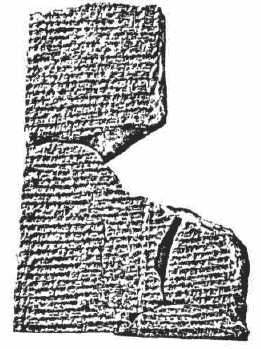
Figure 1
The seventh tablet was devoted to the
exaltation of the supreme Babylonian deity Marduk as he surveyed his
marvelous handiwork (paralleling the biblical seventh "day" on which
God "rested from all His work that He had made"). Scholars now know
that these and other "myths" in their Assyrian and Babylonian
versions were translations of earlier Sumerian texts (modified to
glorify the Assyrian or Babylonian supreme Gods). History, as the
great scholar Samuel N. Kramer has so excellently expounded in his
1959 book of that title, Begins at Sumer.
It all began, we learn from the various texts, a very long time ago,
with the splashing down in the waters of the Persian Gulf or the
Arabian Sea of a group of fifty ANUNNAKI - a term literally meaning
"Those Who from Heaven to Earth Came." They waded ashore under the
leadership of E.A ("He Whose House Is Water"), a brilliant
scientist, and established the first extraterrestrial colony on
Earth, calling it E.RI.DU ("House in the Faraway Built").
Other
settlements followed in pursuit of the visitors’ mission: Obtaining
gold by distilling the waters of the Persian Gulf - gold needed
urgently back on the home planet of
the Anunnaki so that their
dwindling atmosphere could be protected by a shield of suspended
gold particles. As the expedition expanded and the operations were
set in motion, Ea acquired the additional title or epithet EN.KI - "Lord of Earth."
But all did not go well. The home planet (called
NIBIRU) was not
receiving the required gold. A change of plans was soon decided,
calling for the obtainment of the gold the hard way, by mining it in
the AB.ZU - southeastern Africa. More Anunnaki arrived on Earth (in
the end they numbered 600); another group, the IGI.GI ("Those Who
Observe and See") remained skyborne, operating shuttlecraft and
spacecraft and space stations (they numbered, Sumerian texts assert,
300 in all).
To make sure there were no failures this time,
ANU
("The Heavenly One"), ruler of Nibiru, sent to Earth a half brother
of Enki/Ea, EN.LIL ("Lord of the Command"). He was a strict
disciplinarian and a firm administrator; and while Enki was sent to
oversee the mining of gold ores in the Abzu, Enlil took over command
of the seven Cities of the Gods in the E.DIN ("Home of
the Righteous
Ones"), the place where more than 400,000 years later the Sumerian
civilization blossomed out.
Each such city was assigned specialized
functions: a Mission Control Center, a Spaceport, a center for
metallurgy; even a medical center under the supervision of NIN.MAH
("Great Lady"), a half sister of both Enki and Enlil.
The evidence, presented and analyzed by us in
books I-V of The Earth
Chronicles series and the companion book
Genesis Revisited,
indicated a vast elliptical orbit for Nibiru that lasts 3,600
Earth-years, a period called SAR in Sumerian. Sumerian records of
prehistoric times, called
King Lists, measured the passage of time
as applied to the Anunnaki in Sars.
Scholars who have uncovered and
translated these texts find the lengths of the tours of duty of
named Anunnaki commanders nothing short of "legendary" or
"fantastic," for such individual "reigns" lasted 28,800 or 36,000 or
even 43,200 years. But in fact the Sumerian King Lists state that
this or that commander was in charge of a certain settlement for 8
or 10 or 12 Sars. Converted to Earth-years these numbers become the
"fantastic" 28,800 (8 x 3,600) and so on;
but in Anunnaki terms they were just eight or ten of their years, a
perfectly reasonable (and even short) length of time.
Therein, in the Sars, lies the secret to the apparent immortality
of the ancient "Gods." A year, by definition, is the time it takes
the planet one lives on to complete one orbit around the Sun. The
orbit of Nibiru lasts 3,600 Earth-years; but for those who live on
Nibiru, that amounts to only one of their years. The Sumerian and
other Near Eastern texts speak of both the birth and the death of
those "Gods"; except that, in the eyes of the Earthlings (for that,
literally, is what Adam - "He of Earth" - meant in Hebrew), the life
cycles of the Anunnaki were such that, in human terms, they were
immortal for all practical purposes.
The Anunnaki arrived on Earth 120 Sars before the Deluge - 432,000
Earth-years before that avalanche of water that was a watershed
event in more than physical ways. Man, The Adam, was not yet on
Earth when the Anunnaki arrived. For forty Sars the Anunnaki who
were sent to the Abzu toiled mining the gold; but then they
mutinied.
A text in Akkadian (the mother tongue of Babylonian,
Assyrian, and Hebrew) called
Atra Hasis describes the mutiny and the
reasons for it in vivid detail. Enlil called for disciplinary
measures to force the Anunnaki to continue toiling and to punish the
mutiny’s instigators. Enki was for leniency. Anu was consulted; he
sympathized with the mutineers. How was the impasse to be resolved?
Enki, the scientist, had a solution.
Let us create a Primitive
Worker, he said, that will take over the backbreaking toil. The
other leaders of the Anunnaki present wondered: How can it be done,
how can an Adamu be created? To which Enki gave this answer:
The creature whose name you uttered, it exists!
He found the "creature" - a hominid, the product of evolution on
Earth - in southeast Africa, "above the Abzu." All that we need to do
to make it an intelligent worker, Enki added, was to:
Bind upon it the image of the Gods.
The assembled Gods - the Anunnaki leaders - agreed enthusiastically. On
Enki’s suggestion they summoned Ninmah, the Chief Medical Officer,
to assist in the task.
"You are the midwife of the Gods," they said
to her - "Create Mankind! Create a Mixed One that he may bear the
yoke, let him bear the yoke assigned by Enlil, let the Primitive
Worker toil for the Gods!"
In Chapter 1 of Genesis the discussion that led to this decision is
summed up in one verse:
"And Elohim said: Let us make the Adam in
our image, after our likeness."
And, with the implied consent of the
assembled "us," the task was carried out:
"And Elohim created the
Adam in His image; in the image of Elohim created He him."
The term image - the element or process by which the existing
"creature" could be raised to the level desired by the Anunnaki,
akin to them except for Knowing and Longevity - can best be
understood by realizing who or what the existing "creature" was. As
other texts (e.g. one that scholars title
The Myth of Cattle and
Grain) explain,
When Mankind was first created They knew not the eating of bread.
knew not the wearing of garments. They ate plants with their mouths,
like sheep; They drank water from the ditch.
This is a fitting description of hominids roaming wildly as, and
with, other beasts. Sumerian depictions, engraved on stone cylinders
(so-called "cylinder seals") show such hominids mingling with
animals but standing erect on two feet - an illustration (regrettably
ignored by modern scientists) of a Homo erectus (Fig. 2). It was
upon that Being, that already existed, that Enki had suggested to
"bind upon it the image of the Gods," and create through genetic
engineering an Earthling, Homo sapiens.
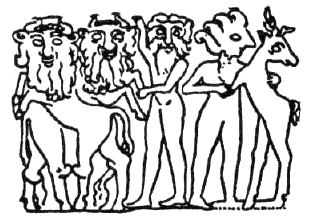
Figure 2
A hint of the process involved in the genetic makeover is made in
the Yahwist Version (as scholars refer to it) in chapter 2 of Genesis, in which we read that,
"Yahweh Elohim formed The
Adam with clay of the earth, and breathed into his nostrils the
breath of life; and the Adam became a living being."
In Atra Hasis
and other Mesopotamian texts a much more complex process involving
the Being is described. It was a creative process not without
frustrating trials and errors until the procedure was perfected and
the desired result was attained by Enki and Ninmah (whom some texts,
in honor of her memorable role, granted her the epithet NIN.TI - "Lady
of Life").
Working in a laboratory called Bit Shimti - "House where the wind of
life is breathed in" - the "essence" of the blood of a young Anunnaki
male was mixed with the egg of a female hominid. The fertilized egg
was then inserted into the womb of a female Anunnaki. When, after a
tense waiting period, a "Model Man" was born, Ninmah held the
newborn baby up and shouted: "I have created! My hands have made
it!"
Sumerian artists depicted on a cylinder seal that breathtaking
final moment, when Ninmah/Ninti held up the new Being for all to see
(Fig. 3). Thus, captured in an engraving on a small stone cylinder,
is a pictorial record of the first Divine Encounter!
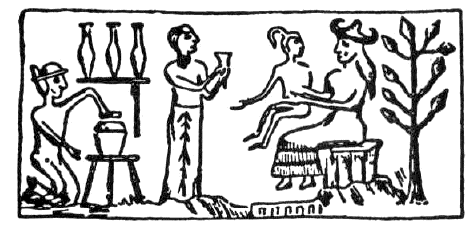
Figure 3
In ancient Egypt, where the Gods were called
Neteru ("Guardians")
and identified by the hieroglyphic symbol of a mining axe, the act
of creating the first Man out of clay was attributed to the
ram-headed God Khnemu ("He who
joins"), of whom the texts said that he was "the maker of men . . .
the father who was in the beginning."
Egyptian artists too, as the
Sumerians before them, depicted pictorially the moment of the First
Encounter (Fig. 4); it showed Khnemu holding up the newly created
being, assisted by his son Thoth (the God of science and medicine).
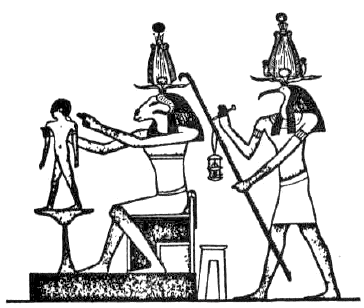
Figure 4
The Adam, as one version in Genesis relates, was indeed created
alone. But once this Model Man proved the validity
of this process of creating "test-tube babies," a project of mass
replication was embarked upon. Preparing more mixtures of TI.IT - "That which is with life," the biblical "clay" - genetically
engineered to produce Primitive Workers of both sexes, Ninmah
placed seven lumps of the "clay" in a "male mould" and seven in a
"female mould."
The fertilized eggs were then implanted in the wombs
of female Anunnaki "birth Goddesses." It was to this process of
bringing forth seven male and seven female "Mixed Ones" at each
shift that the "Elohist Version" (as scholars call it) in Genesis
referred when it stated that when Humankind was created by Elohim,
"male and female created He them."
But, like any hybrid (such as a mule, the result of the mating of a
horse and a she-ass), the "Mixed Ones" could not procreate. The
biblical tale of how the new being acquired "Knowing," the ability
to procreate in biblical terminology, covers with an allegorical
veneer the second act of genetic engineering. The principal actor in
the dramatic development is neither Yahweh-Elohim nor the created
Adam and Eve, but the Serpent, the instigator of the crucial
biological change.
The Hebrew word for "serpent" in Genesis is Nahash. The term,
however, had two additional meanings. It could mean "He who knows or
solves secrets"; it could also mean "He of the copper." The last two
meanings appear to have stemmed from the Sumerian epithet for Enki,
BUZUR, which meant both "He who solves secrets" and "He of the metal
mines."
Indeed, the frequent Sumerian symbol for Enki was mat of a
serpent. In an earlier work (Genesis Revisited) we have suggested
that the associated symbol of Entwined Serpents (Fig. 5a), from
which the symbol for healing has remained to this day, was
inspired - already in ancient Sumer! - by the double helix DNA (Fig. 5b)
and thus of genetic engineering.
As we shall show later on, Enki’s
use of genetic engineering in the Garden of Eden also led to the
double helix motif in Tree of life depictions. Enki bequeathed this
knowledge and its symbol to his son Ningishzidda (Fig. 5c), whom we
have identified as the Egyptian God Thoth; the Greeks called him
Hermes; his staff bore the emblem of the Entwined Serpents (Fig.
5d).
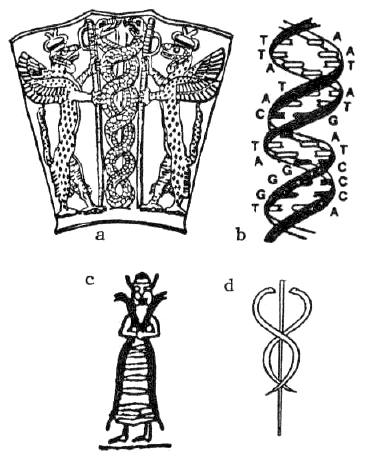
Figures 5a, 5b, 5c, and 5d
As we trace these double and triple meanings of Enki’s
epithets (Serpent-copper-healing-genetics), it behooves us to recall
the biblical tale of the plague that befell the Israelites during
their wanderings in the Sinai wilderness: it stopped after Moses has
made a "copper serpent" and held it up to summon divine help.
It is nothing short of mind-boggling to realize that this second
Divine Encounter, when Humankind was given the ability to procreate,
was also captured for us by ancient "photographers" - artists who
carved the scene in reverse on the small stone cylinders, images
that were seen in positive after the seal was rolled on wet clay.
But such depictions too, in addition to the ones depicting the
creation of The Adam, have been found.
One shows "Adam" and "Eve"
seated, flanking a tree, and the serpent behind Eve (Fig. 6a).
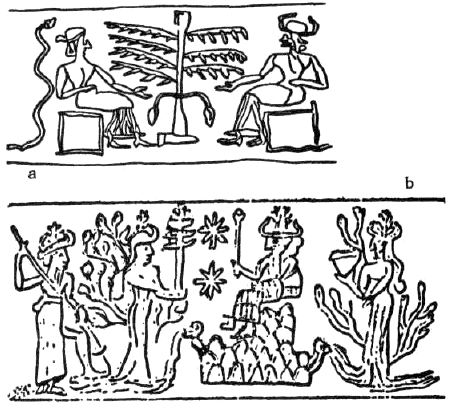
Figures 6a and 6b
Another shows a great God seated atop a throne-like mound from which
two
serpents emanate - undoubtedly Enki (Fig. 6b). He is flanked on the
right by a male whose sprouting branches are penis-shaped, and on
the left by a female whose branches are vagina-shaped and who holds
a small fruit tree (presumably from the Tree of Knowing). Watching
the goings-on is a menacing great God - in all probability an angry
Enlil.
At these texts and depictions, augmenting the biblical narrative,
have thus combined to paint a detailed picture, a course of events
with identifiable principal participants, in the saga of Divine
Encounters. Nevertheless, scholars by and large persist in lumping
all such evidence as "mythology." To them the tale of events in the
Garden of Eden is just a myth, an imaginary allegory taking place in
a nonexistent place.
But what if such a Paradise, a place with deliberately planted
fruit-bearing trees, had really existed at a time when everywhere
else nature alone was the gardener? What if in
the earliest times there had been a place called "Eden," a real
place whose events were real occurrences?
Ask anyone where Adam was created, and the answer will in all
probability be: In the Garden of Eden. But it is not there where the
story of Humankind begins.
The Mesopotamian tale, first recorded by the Sumerians, places the
first phase at a location "above the Abzu" - farther north than where
the gold mines were. As several groups of "Mixed Ones" were brought
forth and pressed into service for the purpose for which they were
created - to take over the toil in the mines - the Anunnaki from the
seven settlements in the E.DIN clamored for such helpers too.
As
those in southeastern Africa resisted, a fight broke out. A text
which scholars call
The Myth of the Pickax describes how, led by Enlil, the Anunnaki from the E.DIN forcefully seized some of "the
Created Ones" and brought them over to Eden, to serve the Anunnaki
there. The text called
The Myth of Cattle and Grain explicitly
states that "when from the heights of Heaven to Earth Anu had caused
the Anunnaki to come," grains that vegetate, lambs and kids were not
yet brought forth.
Even after the Anunnaki in their "creation
chamber" had fashioned food for themselves, they were not satiated.
It was only,
After Anu, Enlil, Enki and Ninmah
had fashioned the black-headed
people,
Vegetation that is fruitful they multiplied
in the land... In the Edin they placed them.
The Bible, contrary to general assumptions, relates the same tale.
As in
the Enuma elish, the biblical sequence (chapter 2 of Genesis)
is, first, the forming of the Heavens and of Earth; next, the
creation of The Adam (the Bible does not state where). The Elohim
then "planted a garden in Eden, eastward" (of where the Adam was
created); and only thereafter did the Elohim "put there" (in the
Garden of Eden) "the Adam whom he had fashioned."
And Yahweh Elohim took the Adam, and placed him in the Garden of
Eden to till it and to keep it.
An interesting light is shed on the "Geography of Creation" (to
coin a term) and, consequently on the initial Divine Encounters, by
the Book of Jubilees. Composed in Jerusalem during the time of the
Second Temple, it was known in those centuries as The Testament of
Moses, because it began by answering the question, How could
Humankind know about those early events that even preceded the
creation of Humankind?
The answer was that it was all revealed to
Moses on Mount Sinai, when an Angel of the Divine Presence dictated
it to Moses by the Lord’s command. The name Book of Jubilees,
applied to the work by its Greek translators, stems from the
chronological structure of the book, which is based on a count of
the years by "jubilees" whose years are called "days" and "weeks."
Obviously drawing on sources that were available at the time (in
addition to the canonical Genesis), such as the books that the Bible
mentions and other texts that Mesopotamian libraries cataloged but
which are yet to be found, the Book of Jubilees, using the enigmatic
count of "days," states that Adam was brought by the angels into the
Garden of Eden only "after Adam had completed forty days in the land
where he had been created"; and "his wife they brought in on the
eightieth day." Adam and Eve, in other words, were brought into
being elsewhere.
The Book of Jubilees, dealing with the expulsion from Eden later on,
provides another morsel of valuable information. It informs us that
"Adam and his wife went forth from the Garden of Eden, and they
dwelt in the Land of Nativity, the land of their creation." In other
words, from the Edin they went back to the Abzu, in southeastern
Africa. Only there, in the second Jubilee, did Adam "know" his wife
Eve and "in the third week in the second jubilee she gave birth to
Cain, and in the fourth she gave birth to Abel, and in the fifth she
gave birth to a daughter, Awan." (The Bible states that Adam and Eve
had thereafter other sons and daughters; noncanonical books say that
they numbered sixty-three in all.)
Such a sequence of events, that places the start of Humankind’s
proliferation from a single primordial mother not in the
Mesopotamian Eden but back in the Abzu, in south-eastern Africa, is now fully corroborated by scientific discoveries
that have led to the "Out of Africa" theories regarding the origin
and spread of Humankind.
Not only finds of fossil remains of the
earliest hominids, but also genetic evidence concerning the final
line of Homo sapiens, confirms southeast Africa as the place where
Humankind originated. And as to Homo sapiens, anthropological and
genetic researchers have placed an "Eve" - a single female of whom all
of present day humans stem - in the same area at about 250,000 years
ago.
(This finding, at first based on DNA that is passed only by the
mother, has been corroborated in 1994 by genetic research based on
Nuclear DNA that is passed from both parents and expanded in 1995 to
include an "Adam" circa 270,000 years ago.)
It was from there that
the various branches of Homo sapiens (Neanderthals, Cro-Magnons)
later arrived in Asia and Europe.
That the biblical Eden was one and the same place settled by the
Anunnaki and the one to which they brought over Primitive Workers
from the Abzu, is almost self-evident linguistically. The name
Eden, hardly anyone now doubts, stemmed from the Sumerian E.DIN via
the intermediary of the Edinnu in Akkadian (the mother tongue of
Assyrian, Babylonian, and Hebrew).
Moreover, in describing the
profusion of waters in that Paradise (an impressive aspect for
readers in a part of the Near East wholly dependent on rains in a
short winter season), the Bible offered several geographical
indicators that also pointed to Mesopotamia; it stated that the
Garden of Eden was located at the head of a body of water that
served as the confluence of four rivers:
And a river went out of Eden
to water the garden;
And from there it was parted
and became four principal streams.
The name of the first is Pishon,
the one which winds through the land
of Havilah, where the gold is -
the land whose gold is good -
there [too] is the bdellium and onyx stone.
And the name of the second river is Gihon;
it is the one that circles
all of the land Kush.
And the name of the third river is Hiddekel,
the one that flows east of Assyria.
And the fourth is the Prath.
Clearly, two of the Rivers of Paradise, the
Hiddekel and the Prath,
are the two major rivers of Mesopotamia (that gave the land its
name, which means "The Land Between the Rivers"), the Tigris and
Euphrates as they are called in English. There is complete agreement
between all scholars that the biblical names for these two rivers
stem from their Sumerian names (via the intermediary Akkadian):
Idilbat and Purannu.
Though the two rivers take separate courses, at some points almost
coming together, at others separating substantially, they both
originate in the mountains of Anatolia, north of Mesopotamia; and
since this is where the headwaters are as riverine science holds,
scholars have been searching for the other two rivers at that
"head-point." But no suitable candidates for the Gihon and Pishon as
two more rivers flowing from that mountain range and meeting the
other qualifications have been found.
The search, therefore, spread
to more distant lands. Kush has been taken to mean Ethiopia or Nubia
in Africa, and the Gihon ("The Gusher") to be the Nile River with
its several cataracts. A favorable guess for Pishon (possibly "The
one who had come to rest") has been the Indus River, equating
therefore Havilah with the Indian subcontinent, or even with
landlocked Luristan. The problem with such suggestions is that
neither the Nile nor the Indus confluates with the Tigris and
Euphrates of Mesopotamia.
The names Kush and Havilah are found in the Bible more than once,
both as geographical terms and as names of nation-states. In the
Table of Nations (Genesis chapter 10) Havilah is listed together
with Seba, Sabtha, Raamah, Sabtecha, Sheba, and Dedan. They were all
nation-lands which various biblical passages linked with the tribes
of Ishmael, the son of Abraham by the handmaiden Hagar, and there is
no doubt that their domains were in Arabia.
These traditions have
been
corroborated by modern researchers that have identified the tribal
locations throughout Arabia. Even the name Hagar was found to be the
name of an ancient city in eastern Arabia. An updated study by E.A.
Knauf (Ismael, 1985) conclusively deciphered the name Havilah as the
Hebrew for "Sand Land," and identified it as the geographic name for
southern Arabia.
The problem with such convincing conclusions has been that no river
in Arabia could qualify as the biblical river Pishon, if for no
other reason than the simple fact that the whole of Arabia is arid,
a huge desert land.
Could the Bible be so wrong? Could the whole tale of the Garden of
Eden, and thus of the events and Divine Encounters in it, be just a
myth?
Starting with a firm belief in the veracity of the Bible, the
following question came to our mind: Why does the biblical narrative
go to relatively great lengths to describe the geography and
mineralogy of the land (Havilah) where the Pishon was; list the land
and describe the circular course of the Gihon River; merely identify
the location ("east of Assyria") of the Hiddekel; and just name the
fourth river, Prath, without any additional identifying landmarks?
Why this descending order of information?
The answer that had occurred to us was that while there was no need
whatsoever to tell the reader of Genesis where the Euphrates was,
and a mere mention of Assyria was enough to identify the Tigris
(Hiddekel) River, it was necessary to explain that the
Gihon - evidently, a lesser-known river by then - was the river that
encompassed the land of Kush; and that the apparently totally
unknown river Pishon was in a land called Havilah, which, devoid of
landmarks, was identified by the products that came from it.
These thoughts began to make sense when, in the late 1980s, it was
announced that scanning of the Sahara desert (in North Africa, in
western Egypt) with soil-penetrating radar from Earth-orbiting
satellites and with other instruments aboard the space shuttle
Columbia, revealed under layers of desert sand dry beds of rivers
that once flowed in this region. Subsequent research on the ground
established that the area was well watered, with major rivers and
many tributaries,
since perhaps 200,000 years ago and until about 4,000 years ago,
when the climate changed.
The discovery in the Sahara desert made us wonder: Could the same
have happened in the Arabian desert? Could it be that when the
version in chapter 2 of Genesis was written - obviously at a time
when Assyria was already known - the Pishon River had entirely
vanished under the sands as the climate changed in past millennia?
Confirmation of the validity of this line of reasoning took place
quite dramatically in March 1993. It was an announcement by Farouk
El-Baz, director of the Center for Remote Sensing at Boston
University, concerning the discovery of a lost river under the sands
of the Arabian peninsula - a river that flowed for more than 530 miles
from the mountains of western Arabia all the way eastward to the
Persian Gulf. There it formed a delta that covered much of today’s
Kuwait and reached as far as the present-day city of Basra,
merging - "confluing" - there with the Tigris and Euphrates rivers. It
was a river that was about fifty feet deep throughout its entire
length and more than three miles wide at some points.
After the last Ice Age, between 11,000 and 6,000 years ago, the
Boston University study concluded, the Arabian climate was wet and
rainy enough to support such a river. But some 5,000 years ago the
river dried up because of climatic changes that resulted in the
aridity and desert-like conditions in the peninsula. In time,
wind-driven sand dunes covered the river’s channel, obliterating all
evidence of the once-mighty river.
High-resolution imaging by Landsat satellites, however, revealed that the dune patterns changed
as the sand crossed a line that extended for hundreds of miles, a
line that ended in mystifying deposits of gravel in Kuwait and near
Basra - gravel of rocks that came from the Hijaz Mountains in western
Arabia. Ground-level inspections then confirmed the existence of the
ancient river (Fig. 7).
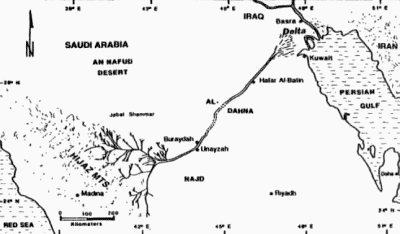
Figure 7
Dr. El-Baz has given the lost river the name
Kuwait River. We
suggest that it was called Pishon in antiquity, cutting across the
Arabian peninsula that indeed was an ancient source of gold and
precious stones.
And what about the river Gihon, "the one that meanders in all of the
land of Kush"? Kush is listed twice in the Table
of Nations, first with the Hamitic-African lands of Egypt, Put
(Nubia/Sudan) and Canaan; and a second time as one of the
Mesopotamian lands where Nimrod was lord, he "whose first kingdoms
were Babylon and Erech and Akkad, all in the land of Shine’ar"
(Sumer). The Mesopotamian Kush was in all probability east of Sumer,
the area of the Zagros Mountains.
It was the homeland of the Kushshu
people, the Akkadian name for the Kassites, who in the second
millennium B.C. swept down from the Zagros Mountains and occupied
Babylon. The ancient name was retained as Kushan for the district
of Susa (the "Shushan" of the biblical Book of Esther) well into
Persian and even Roman times.
There are several noteworthy rivers in that part of the Zagros
Mountains, but they have not caught the attention of scholars
because none of them share headwaters with the Tigris and Euphrates
(which begin hundreds of miles to the northeast). Here, however,
another thought came into play: Could the ancients have spoken of
rivers that join together not at their headwaters, but at their
confluence into the Persian Gulf? If so, the Gihon - the fourth river
of Eden - would have been a river that joins the Tigris, the
Euphrates, and the newly discovered "Kuwait River" at the head of
the Persian Gulf!
If the problem is looked at thus, the obvious candidate for
the Gihon easily emerges. It is the Karun River, which is indeed the
major river of the ancient land of Kushshu. Some five hundred miles
in length, it forms an unusual loop, starting its tortuous flow in
the Zardeh-Kuh range in what is now southwestern Iran. Instead of
flowing down south to the Persian Gulf, it flows "upward" (as one
looks at a modern map) in a northwesterly direction, through deep
gorges.
Then it makes a loop and begins to flow southward in a
zigzagging course as it leaves the high mountains of the Zagros
range and starts a descent toward the gulf. Finally, in its last
hundred miles or so, it mellows and meanders gently toward a
confluence with none other than the Tigris and Euphrates in the
marshy delta they form at the head of the Persian Gulf (the
so-called Shatt-el-Arab, nowadays contested between Iran and Iraq).
The location, the circular course, the gushing, the confluence with
the other three rivers at the head of the Persian Gulf, all suggest
to us that the Karun River could well be the biblical river
Gihon
that circled the land of Kush. Such an identification, combined with
the space-age discoveries of the major river in Arabia, by so
delineating and identifying the location of the Garden of Eden in
southern Mesopotamia, confirm the physical existence of such a place
and form a sound foundation of fact, not myth, under the related
tales of Divine Encounters.
Confirmation of southern Mesopotamia,
ancient Sumer, as the E.DIN,
the original biblical Eden, does more than create a geographic
congruency between the Sumerian texts and the biblical narrative. It
also identifies the group with whom Humankind had Divine
Encounters. The E.DIN was the abode ("E") of the DIN ("The
Righteous/Divine Ones"). Their full title was DIN.GIR, meaning "The
Righteous Ones of the Rocketships," and was written pictographically
as a two-stage rocket whose command module could separate for
landing (Fig. 8a).
As the script evolved from pictographic to the wedgelike cuneiform, the pictograph was replaced by a star symbol
meaning "Heavenly Ones"; later on, in Assyria and Babylon, the
symbol was simplified to crossed wedges (Fig.
8b) and its reading, in the Akkadian language, changed to Ilu - "The
Lofty Ones."
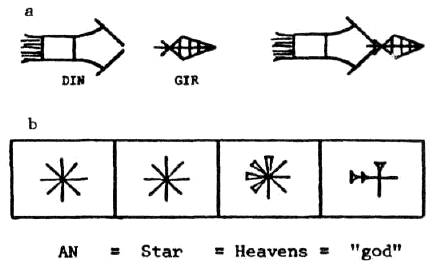
Fig. 8a and 8b
The Mesopotamian Creation texts provide not just the answer to the
puzzle of who were the several deities involved in the creation of
The Adam, causing the Bible to employ the plural Elohim ("The Divine
Ones") in a monotheistic version of the events and to retain the
"us" in "Let us make Man in our image and after our likeness"; they
also provide the background for this achievement.
The evidence leaves little room for doubting that the Elohim of
Genesis were the Sumerian DIN.GIR. It was to them that the feat of
creating The Adam was attributed, and it was their diverse (and
often antagonistic) leaders - Enki, Enlil, Ninmah - who were the "us"
whom the first Homo sapiens first encountered.
The expulsion from the Garden of Eden brought to an end the first
chapter in this relationship. Losing Paradise but gaining knowledge
and the ability to procreate, Humankind was henceforth destined to
be bonded with Earth -
In the sweat of thy brow
shalt thou eat bread,
until your return to the earth,
for from it wast thou taken.
For thou art earthdust
and unto earthdust thou shall return.
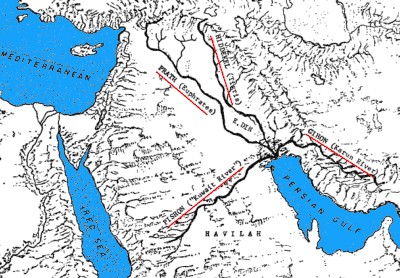
The E.DIN and its four rivers
But that is not how Humankind saw its destiny. Being created in the
image, after the likeness, and with the genes of the Dingir/Elohim,
it saw itself part of the heavens - the other planets, the stars, the
universe. It strives to join them in their celestial abode, to gain
their immortality.
To do so, the ancient texts tell us, Man has
continued to seek Divine Encounters without weapons-bearing Cherubim
blocking the way.
|
The First Language
Could Adam and Eve speak, and in what language did they converse
with God?
Until a few decades ago modem scholars held that human speech began
with Cro-Magnon Man some 35,000 years ago and that languages
developed locally among diverse clans no more than 8,000 to 12,000
years ago.
This is not the biblical view according to which Adam and Eve
conversed in an understandable language, and that prior to the Tower
of Babel incident "the whole Earth was of one language and one kind
of words."
In the 1960s and 1970s word comparisons led scholars to conclude
that all the thousands of different languages-including those of
Native Americans - could be grouped into three primary ones. Later
fossil discoveries in Israel revealed that 60,000 years ago
Neanderthals could already speak as we do. The conclusion that there
indeed had been a single Mother Tongue some 100,000 years ago has
been confirmed in mid-1994 by updated studies at the University of
California at Berkeley.
The advances in genetic research, now applied to speech and
language, suggest that these abilities, distinguishing humans from
apes, are of a genetic origin. Genetic studies indicate that there
indeed had been an "Eve," a sole mother of us all-and that she
appeared 200,000-250,000 years ago with "the gift of gab."
Some Fundamentalists would believe that the Mother Tongue was
Hebrew, the language of the Holy Bible. Perhaps, but probably not:
Hebrew stems from Akkadian (the first "Semitic" language) that was
preceded by Sumerian. Was it then Sumerian, the language of the
people who had settled in Shine’ar? But that was only after the
Deluge, whereas Mesopotamian texts refer to a pre-Diluvial
language.
Anthropologist Kathleen Gibson of the University of Texas
at Houston believes that humans acquired language and mathematics at
the same time. Was the First Language that of the Anunnaki
themselves, taught to Mankind as all other knowledge? |
Back
to Contents
Back to Gold for Humans and Others...
|









